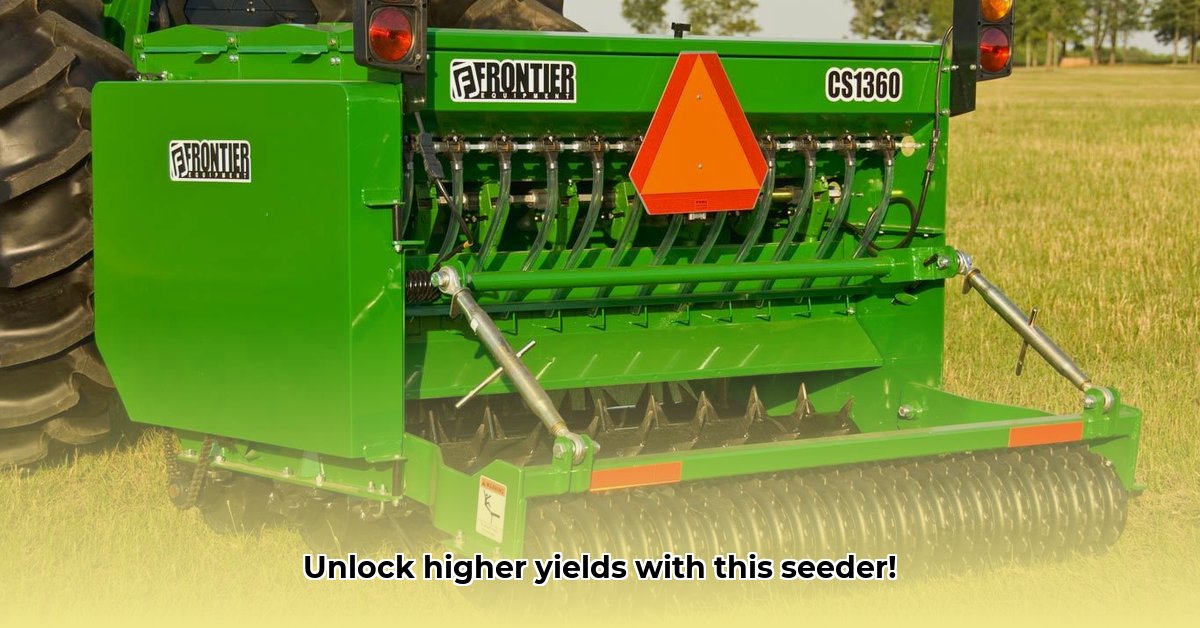
Getting the most from your planting season hinges on efficiency and precision. The BEFCO Seed-Rite 3-point seeder aims to deliver both, promising improved yields through accurate seed placement. This detailed review examines its features, performance, ease of use, sustainability aspects, and compares it to potential alternatives. We'll also provide actionable steps for maximizing its performance and longevity. For more tractor implement options, check out this resource.
Features and Specifications: A Closer Look at the Seed-Rite
The BEFCO Seed-Rite is a 3-point hitch seeder designed for small to medium-sized farms. Its core strength lies in its ability to place seeds consistently and accurately, minimizing waste and maximizing germination rates. Let's delve into the specifics:
Seed Cups: Ten individual seed cups ensure even spacing (approximately 7.4 inches apart), promoting healthy plant growth by reducing competition for resources.
Hopper Capacity: A 7 cubic foot hopper is sufficient for smaller fields. While requiring more frequent refills than larger models, its manageable size suits farms with moderate acreage.
Seeding Width: The 74-inch (188cm) seeding width is typical for 3-point seeders. This width affects field coverage – consider your field size when evaluating its suitability.
Ground Drive System: This system adapts to various soil conditions, enhancing versatility across different crop types and terrains.
Wind-Guarded Seed Drop: This crucial feature protects seeds from being blown away by wind, ensuring accurate placement and minimizing seed loss, a significant factor impacting yield and profitability.
Tractor Compatibility: Requires a tractor with a horsepower (hp) rating between 25 and 70 hp. Verify your tractor’s specifications before purchase to ensure compatibility.
Performance Evaluation: Precision and Practicality
The manufacturer highlights the Seed-Rite's precision seeding capabilities. To validate this claim, independent user testing and data (such as seeding speed per acre and actual germination rates) would be beneficial. While initial observations suggest accurate seed placement, real-world performance data across diverse soil conditions and seed types is crucial for a comprehensive evaluation. How does seeding speed and accuracy vary with soil type and seed size? This requires further investigation.
Ease of Use and Maintenance: A Practical Guide
Setting up and calibrating the Seed-Rite is seemingly straightforward. However, clear and detailed visual instructions are crucial for optimal setup and calibration. Regular maintenance is key to longevity and reliable performance. Unfortunately, readily available information on maintenance schedules, parts availability, and common troubleshooting is currently limited. BEFCO could significantly enhance user confidence and satisfaction by providing comprehensive maintenance and troubleshooting guides.
Step-by-Step Maintenance Guide
Pre-Season Inspection: Before each planting season, thoroughly inspect the entire unit. Check for damaged parts, loose bolts, or worn components. Lubricate all moving parts according to the manufacturer's instructions. (Refer to the BEFCO Seed-Rite Manual for precise lubrication points).
Calibration: Accurate calibration is critical for consistent seed distribution. Before each use, carefully follow the manufacturer's calibration instructions. This typically involves adjusting seed cup settings to achieve optimal seed spacing.
Post-Season Cleaning: After each use, thoroughly clean the hopper, seed cups, and rollers. Remove all debris, leftover seeds, and soil. Store the seeder in a dry location to prevent rust and corrosion.
Regular Part Replacement: Replace worn parts proactively. The manufacturer’s recommended replacement schedule should be followed for components with a limited lifespan, such as the nylon/fiberglass rings on the corrugated rollers and seed cups.
Troubleshooting: Familiarize yourself with common problems and their solutions. The owner's manual is an invaluable resource when addressing issues.
Sustainability Aspects: Environmental Impact
Precision seeding inherently promotes sustainable agriculture. By reducing seed waste, precision seeding, like that offered by the Seed-Rite, lowers input costs and minimizes the environmental impact linked to seed production and transportation. However, the manufacturing process and material sourcing of the seeder itself, as well as its transportation to the farm, have environmental implications. A complete life-cycle assessment is needed for a thorough evaluation of its environmental footprint.
Comparison with Alternatives: Market Positioning
Direct comparison with similar 3-point seeders is hampered by a lack of readily available comparative data. Further research focusing on price, features, long-term reliability, and user reviews of competing models is necessary to fully assess the Seed-Rite's standing in the market. Factors such as seeding capacity and GPS integration should be considered when comparing alternatives.
Conclusion and Recommendation
The BEFCO Seed-Rite 3-point seeder shows promise for smaller farms focused on precision planting and reduced seed waste. Its relatively straightforward operation and apparent durability are attractive features. However, the limited hopper capacity and the absence of extensive user reviews and long-term reliability data require cautious consideration. Before purchasing, thoroughly investigate maintenance requirements, parts availability, and the seeder’s overall lifespan to determine its suitability for your specific farm needs and scale. For larger farms, exploring higher-capacity options might be more economically practical.